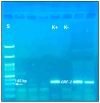First Detection of Hepatitis E Virus RNA in Ovine Raw Milk from Herds in Central Italy
- PMID: 39456280
- PMCID: PMC11507303
- DOI: 10.3390/foods13203218
First Detection of Hepatitis E Virus RNA in Ovine Raw Milk from Herds in Central Italy
Abstract
HEV mainly enters animal and human hosts through the orofecal route, which presents a critical health concern alongside the associated environmental variable. Among products of animal origin, milk (both ovine and bovine) can harbor HEV RNA, which can potentially be transmitted to consumers. In this study, a total of 220 raw ovine milk samples were collected from Apennine breed subjects farmed (transhumance method) in three different Italian provinces, L'Aquila, Pescara, and Teramo, located in the Abruzzo region (Central Italy). All the specimens were screened using one-step real-time RT-qPCR and nested RT-PCR assays. Among them, 5/220 or 2.27% harbored HEV RNA fragments belonging to the ORF1 and ORF2 codifying regions of the genotype 3c. The average viral amount discovered was 102 GE/mL. These subjects represented 2/57 or 3.51% of the Pescara herd, and 3/105 or 2.86% of the Teramo herd. Although HEV RNA was discovered in sheep fecal samples, the original data obtained in the present study represent the first HEV RNA detection in ovine raw milk from Italy.
Keywords: RNA; food safety; hepatitis E virus; molecular biology; ovine; public health; raw milk.
Conflict of interest statement
The authors declare no conflicts of interest.
Figures


Similar articles
-
[Detection of HEV RNA amounts and genotypes in raw milks obtained from different animals].Mikrobiyol Bul. 2019 Jan;53(1):43-52. doi: 10.5578/mb.67468. Mikrobiyol Bul. 2019. PMID: 30683038 Turkish.
-
Hepatitis E Virus (Genotype 3) in Slurry Samples from Swine Farming Activities in Italy.Food Environ Virol. 2017 Jun;9(2):219-229. doi: 10.1007/s12560-016-9270-4. Epub 2016 Nov 16. Food Environ Virol. 2017. PMID: 27853931
-
High prevalence of hepatitis E virus in raw sewage in Southern Italy.Virus Res. 2019 Oct 15;272:197710. doi: 10.1016/j.virusres.2019.197710. Epub 2019 Aug 12. Virus Res. 2019. PMID: 31415790
-
Detection of hepatitis E virus in milk: Current evidence for viral excretion in a wide range of mammalian hosts.Transbound Emerg Dis. 2022 Nov;69(6):3173-3180. doi: 10.1111/tbed.14683. Epub 2022 Sep 1. Transbound Emerg Dis. 2022. PMID: 35989468 Review.
-
A Systematic Review and Meta-Analysis on Hepatitis E Virus Detection in Farmed Ruminants.Pathogens. 2023 Apr 2;12(4):550. doi: 10.3390/pathogens12040550. Pathogens. 2023. PMID: 37111437 Free PMC article. Review.
Cited by
-
Hepatitis E Virus in the Role of an Emerging Food-Borne Pathogen.Microorganisms. 2025 Apr 12;13(4):885. doi: 10.3390/microorganisms13040885. Microorganisms. 2025. PMID: 40284721 Free PMC article. Review.
References
LinkOut - more resources
Full Text Sources

